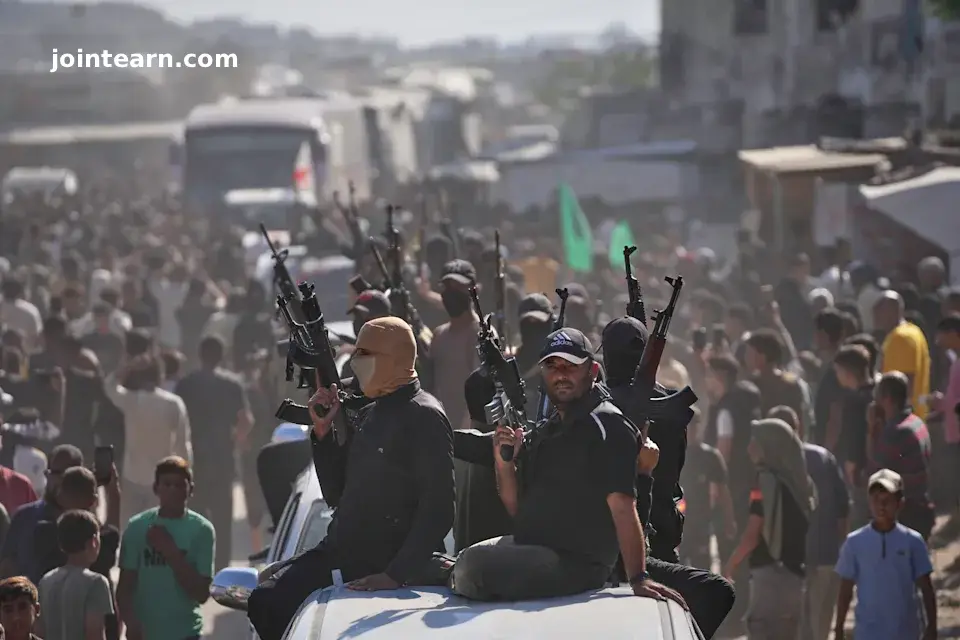
As a tenuous ceasefire continues in Gaza, Hamas security forces have returned to the streets, clashing with armed gangs and targeting criminal elements in what the militant group says is an effort to restore law and order. While some Palestinians have welcomed the renewed security, the move also underscores the fragility of the ceasefire following the release of all living hostages captured in Hamas’ October 7, 2023, attacks.
Hamas Security Forces Return Amid Chaos
Hamas gunmen have been actively patrolling areas previously left under the control of local militias and armed families, including factions backed by Israel. The clashes have resulted in the deaths of multiple gang members, including individuals accused of looting humanitarian aid, robbing civilians, and maintaining control over evacuated zones.
Nahed Sheheiber, head of Gaza’s private truckers union, described Hamas’ intervention as a necessary response to gangs terrorizing people in regions previously controlled by Israeli forces. “Those gangs looted aid and killed people under the protection of the occupation,” Sheheiber said.
The renewed show of force included confrontations with armed groups affiliated with the powerful Doghmush family in Gaza City following the killing of Hamas militant Mohammed Aqel. Eyewitnesses report that clashes resulted in roughly two dozen deaths, including a local journalist and the son of a senior Hamas official living abroad.
Extrajudicial Killings Spark Human Rights Concerns
Hamas-linked security channels released footage claiming to show the execution of gang members in the streets, sparking condemnation from human rights organizations such as the Al Mezan Center for Human Rights and the Palestinian Independent Commission for Human Rights. The killings, framed as targeting “collaborators and traitors,” raise concerns about the use of force and the potential for further destabilization.
The Doghmush family initially distanced itself from the gangs and later condemned Hamas’ heavy-handed response, calling the violence “unnecessary.”
Ceasefire Challenges and Political Implications
Israeli Prime Minister Benjamin Netanyahu has emphasized that Israel’s military objectives will continue until Hamas is disarmed. Similarly, U.S. President Donald Trump’s ceasefire plan calls for Hamas to surrender its military capabilities to an internationally supervised body—an authority that has yet to be established.
Hamas has expressed conditional willingness to hand over heavy weapons, such as rockets, to a Palestinian or Arab oversight body but insists on retaining light arms, like assault rifles, for local defense. Analysts warn that the continued presence of armed gangs opposed to Hamas, some reportedly supported by Israel, complicates both the ceasefire and ongoing disarmament negotiations.
Public Response and Steps Toward Stability
For ordinary Gazans, the return of Hamas forces is seen as a step toward normalcy after two years of intense conflict and lawlessness. Saeed Abu Elaish, a medic from the Jabaliya refugee camp, said police returning to the streets represents a first attempt at restoring “some kind of normalcy and safety.”
The Hamas-run Interior Ministry announced a weeklong amnesty for gang members not implicated in bloodshed, offering expunged records for those who surrender. Those who refuse face arrest and prosecution. Despite this, anti-Hamas militias, such as the group led by Hossam al-Astal, continue to operate in southern Gaza, openly challenging Hamas authority and threatening to undermine security efforts.
The Road Ahead
While Hamas has reestablished a degree of control, the ceasefire remains fragile. Ongoing clashes with rival armed groups, extrajudicial killings, and the retention of weapons by both Hamas and anti-Hamas militias all threaten to destabilize the region.
Israel and international mediators continue to press for complete disarmament of Hamas, but achieving a peaceful transition of power will require delicate negotiations, strict enforcement of ceasefire terms, and continued monitoring of militant and criminal activity across Gaza.
Leave a Reply